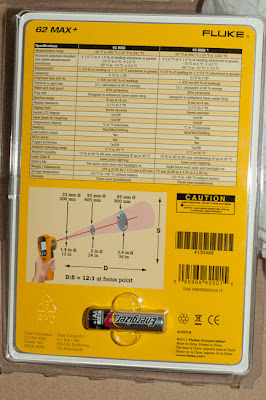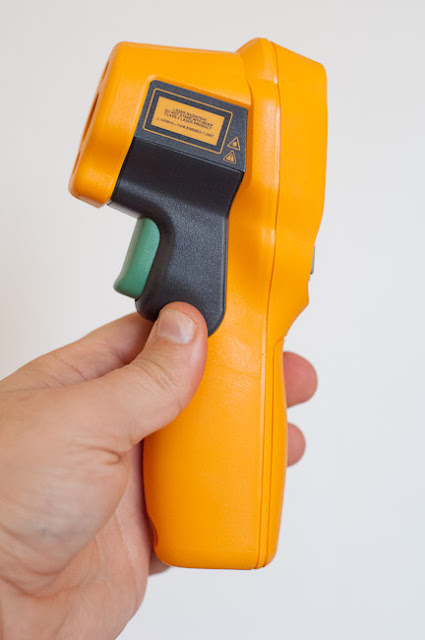 Thanks to Conrad I had the ability to test the Fluke 62Max+ IR Thermometer.
Thanks to Conrad I had the ability to test the Fluke 62Max+ IR Thermometer. IR Thermometers are not necessary for all of us, but can be very helpful. The Fluke is designed for high Temperature ranges (
up to 650°C) and tough environments (
IP54 and Drop tested). Certainly the price is higher than a cheap Chinese model, but the quality is very good as well.
I received the
Fluke 62Max+ well packed.
About the package of the IR Thermometer itself:
My first impression when I saw it online was that It’s one of those plastic packages you need to cut open and twist around to get it open. When I finally had it in my hands that was changed to a positive. It is indeed a clear plastic display package, but you can fold it open. So you get the meter out easily and you can keep the package (if you may think of reselling it one day).
A little minus is about the screen protector. It is imprinted with the display digits, so you have to peel it off and can’t keep it on the display for protection.
All in all the packing seems rugged enough, but one of the strong marketing points of the
Fluke 62Max+ is it’s robustness anyway. So you wouldn’t need to worry here when it is getting shipped to your address.

 In the package
In the package there is the Thermometer itself, an energizer AA battery (the Fluke only needs one AA to run), a printed manual, a warranty card and a clip for the meter to attach it to your belt or tool bag.
That means the meter is ready to go when you receive it. I would have preferred a case or holster for the thermometer, but as Fluke even doesn’t ship their top-end multimeters with a protective bag, this wasn’t a surprise for me.
About the handbook: Well, I am a bit mixed about that. It is a big bonus that you actually get a printed manual and not just a CD or Mini-CD with a PDF. It seems a lot of manufacturers go back to real hardcopies and I highly appreciate that! Most of the manual is described by pictograms which is always considered to be the best way to teach people. There are a few annotations and not every image really makes clear what they want to tell you. For example I still "guess" by Trig in the menu, they mean an auto power off. Next point would the warning about the emissivity, which is right, but leaves you a bit alone in the manual. In a pictogram it is shown how to set the emissivity, but for new owners it isn’t really clear what that function does and why it is so important. They also give you a warning to look up the emissivity in the table, but there is no table supplied in the manual. So there could be some improvement on the manual.
Aside from all that I find it really nice to get a quality battery delivered with the meter. I received a lot of entry-level equipment (well, the Fluke is certainly not in that level) just with with some cheap batteries.
 So let’s get started with that fellow
So let’s get started with that fellow. The
62Max+ feels really good in my hands. It feels rugged on nothing makes a noise when I twist and press on the case. So the Thermometer is from very good built quality. The case is "rubberized" (or made from an Elastomer) and so the Thermometer sits securely in your hand, even with gloves. Well, personally I try to avoid gloves as much as possible, but sometimes you really need them/should wear them to keep your hands protected. It is good to know that you can then still rely on the Fluke and set it up with your gloves on.
I really don’t have very big hands either and so I often have "problems" to keep something gripped in my hand, as these are developed for bigger hands. One example: I need to stretch my fingers quite a lot when I want to hold my Multimeter in my palm. That can become uncomfortable after a while. With the Fluke there is no such problem. It really feels like designed for your hand. I like that a lot.
As it is some kind of gun-grip, it is also designed to be used one handed. There is no problem of reaching the buttons under the lcd with just your thumb.

The laser marks are two points which define the diameter of the area that is measured by the 63Max+ at the current distance. So with increasing distance the diameter will increase too, what is not that surprising. The lens has a 12:1 magnification that mean, you’ll have an 1cm sample-spot at a distance of 12cm.
The Thermometer is rated as IP54 which means it will be protected from splash-water. So you can use it in the rain, but avoid diving with it. Fluke also claims it can handle a fall from a height of 3m. I haven’t tried that, but I don’t doubt that either.
Due to a sealing, the battery compartment lid is a bit tight. So if you have unscrewed it, you need your fingernails to peel out the cover.
 I think we had enough of the case right now and I’ll switch to the LCD
I think we had enough of the case right now and I’ll switch to the LCD.
Most of the LCD can be seen clearly and is in big letters; well, at least the Temperature is. The secondary digits like Min, Max or Avg temperature are much smaller and squeezed into the lower right corner of the LCD. These could have been better for users with weak eyes, but you can read it.. On the other side, the contrast is very good and you can easily read the Temperature. The back-light is pretty bright and gray with a slight blue tint. In dark area it is very good to read and had a nice contrast to the red laser marks.

